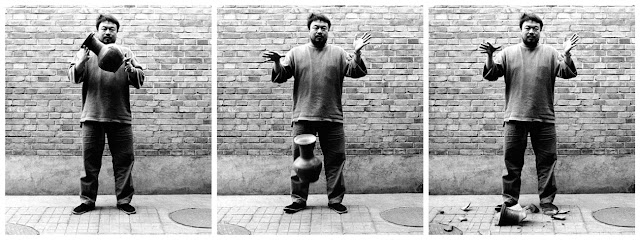Ai Weiwei in London... (Part I)
8:36 p.m.
"Each piece I make is connected with my beliefs and if it does not expresses them so, then my work is worth nothing."
Ai Weiwei
09/11/15 - Chinese artist Ai Weiwei (1957) is presenting a group of works (from 1993 till today) at the Royal Academy of Arts in London. The success is such that on weekends the venue remains open till midnight. The exhibition was curated by Weiwei himself and it opens with a 1:1 scale instalation called Tree, at the courtyard. It is made with pieces of fallen trees from the southern mountains of China and gathered at the artist's studio in Beijing. The meaning: people of different cultures and geographies have come together to form one unique China.
Ai Weiwei uses his work to express his claim for human rights and against censorship, specially in today's China. Admirer of Duchamp and son of a poet, Weiwei carries a beard which is quite unusual for someone living in Beijing, commonly associated to Confucio or Fidel Castro.
A tireless creator, he collaborated in the building of the Olympic stadium Bird’s Nest, although he is known worldwide for his fight against China's inhuman urban planning. All these aspects of the artist are important to fully understand his work, because his criticism against totalitarianism and the violation of human rights are his tune of freedom. Ai Weiwei carries a scar in his head due to a strong beating by the police and that probably explains why he is so unfriendly to people in general.
One of his most renowned works is the portrait "Dripping a Han Dynasty Urn", on display in this exhibition, which is a photographic document of a 1995 performance in which he crashes a 2000-year old antiquity. Those who value cultural objects can not feel indifferent. But Weiwei does not want to discredit the past; on the contrary, he values those vases that have been destroyed by the Communist Party in the Cultural Revolution. Everything else falls into another category and into that one he includes the vase he crashes or the other one he paints with elements of the West.
One of his most renowned works is the portrait "Dripping a Han Dynasty Urn", on display in this exhibition, which is a photographic document of a 1995 performance in which he crashes a 2000-year old antiquity. Those who value cultural objects can not feel indifferent. But Weiwei does not want to discredit the past; on the contrary, he values those vases that have been destroyed by the Communist Party in the Cultural Revolution. Everything else falls into another category and into that one he includes the vase he crashes or the other one he paints with elements of the West.
Dripping a Han Dynasty Urn, by Ai Weiwei (1995)
B&W photo triptych
Royal Academy of Art, London
Coca-Cola vase, by Ai Weiwei (2014)
Han Dynasty vase (206 BC - 220 AD) with paint
Coloured vases, by Ai Weiwei (2015)
Twelve Han dynasty (206 B.C. - 220 A.C.) and four neolithic (5000 a 3000 A.C) vases with industrial paint.
“What contemporary art does is make you see the world in a different way”, Ai Weiwei told Sara Thornton and she adds that Ai enjoys his audacity. In April 2011 he was arrested at Beijing's airport, his house was broken into and his computers confiscated. All this was the result of his online campaign for the dead students of Sichuan 2008 earthquake. Ai explained that all those deaths showed how poorly the houses of the students' campus were built by the Chinese government. Because of that experience, he created S.A.C.R.E.D., a work that shows his life during detention, in which he was always controlled by two high security guards. Six square structures of oxidised metal with tiny windows let us see the artist and his guards (made of fibreglass) in daily situation. His detention was disastrous for the Chinese government because he became more popular because of it.
S.A.C.R.E.D., de Ai Weiwei (2011-2013)
Six-part work composed of six dioramas – Supper, Accusers, Cleansing, Ritual, Entropy, Doubt.
Six-part work composed of six dioramas – Supper, Accusers, Cleansing, Ritual, Entropy, Doubt.
Fiberglass, iron, oxidized metal, wood,
polystyrenen, sticky tape / Measures 377 x 198 x 153 cm each
(To be continued...)
Keep reading... "33 Artist in 3 Acts", by Sara Thornton (2014), Granta Publications, London.














0 comentarios